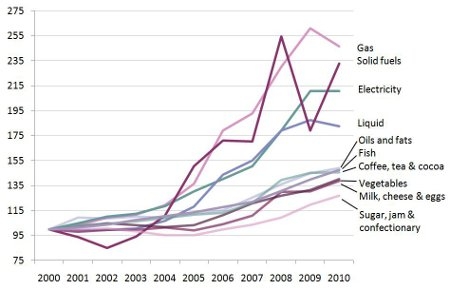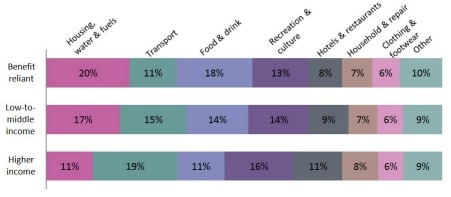 Recent reports of rising food prices have reinforced existing concerns about high rates of inflation. James Plunkett finds that the costs of inflation in recent years have become less equally distributed across incomes, with those on lower incomes feeling the pinch the most. This ‘new inflation’ needs a new policy response.
Recent reports of rising food prices have reinforced existing concerns about high rates of inflation. James Plunkett finds that the costs of inflation in recent years have become less equally distributed across incomes, with those on lower incomes feeling the pinch the most. This ‘new inflation’ needs a new policy response.
There’s been a great deal of debate recently about the political implications of higher inflation. Ironically, recent news of record food prices could relieve the pressure on the Bank of England Governor. His argument for caution when it comes to a rate rise is based on the claim that UK inflation is now being driven by events beyond the MPC’s control. These figures reinforce that case, showing that global commodity prices remain a key driver of the rising cost of living in Britain’s households.
The same argument doesn’t really work for the Chancellor, whose remit isn’t just to keep headline inflation down, but also to help households cope with the kind of inflation we’re now seeing – whatever its cause. In fact, the changing ‘shape’ of inflation, and the shift in weighting towards food and fuel, makes life even more difficult for anyone trying to develop a political or policy response.
In this respect, two particularly worrying aspects of the new inflation emerge from a report we published at the Resolution Foundation in May. First, the big pressures on household budgets are now coming from categories of spending that are hard to avoid. The below chart shows the top ten categories of CPI inflation since 2005. It confirms what is often claimed – food and fuel have taken the front seat. If that is sustained over time, it will see necessities eat up a bigger share of household budgets. The share of income that feels genuinely discretionary or ‘disposable’ will fall. Life will feel more pressured.
Top ten subcategories of CPI inflation since 2005

Index, 2000 = 100
Second, the new inflation is driven by categories in which spend is much less evenly distributed across the population. While the share of spend on some categories like clothing or household goods is fairly evenly spread across income groups, spend on food, housing and fuel is very uneven. On average, households on above average incomes spend around 11 percent of their income on food and 11 percent on housing, water and fuels. Low-to-middle income households spend 14 percent and 17 percent respectively.
Different spending patterns by income group

Share of spend
The new inflation is therefore far more regressive than the old, a point that’s been made elsewhere. But it’s also more volatile in terms of how progressive or regressive it is from year to year. In the entire period from 1989 to 2006, the difference in the actual (CPI) inflation experienced by households on higher incomes and those on low-to-middle incomes was never greater than plus or minus 0.5 percent. In 2008, with inflation more heavily driven by those uneven categories of food and fuel, true CPI inflation was a whole one percentage point higher for households on low-to-middle income than for households on above average income.
When it comes to policy responses in this area, the public debate rarely gets beyond petrol duties and VAT. But the reality is that the government oversees a whole suite of policies that alter the profile of household living costs, and people’s ability to meet them. From the indexing of benefits to competition policy to specific support for work-related costs like childcare, much of this infrastructure was designed for different times. If recent trends continue, it’s going to need an overhaul.
This blog first appeared on Coffeehouse on 31 May.
Please read our comments policy before commenting.








1 Comments